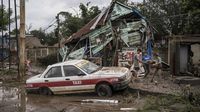For residents in central and southeastern Mexico, the second week of October 2025 will be remembered for scenes of devastation that few could have anticipated. Torrential downpours, fueled by Tropical Storm Priscilla—formerly a hurricane—and Tropical Storm Raymond, unleashed catastrophic floods and landslides across multiple states, leaving at least 41 people dead and dozens more missing, according to the Associated Press and corroborated by Mexico’s National Coordination of Civil Protection.
The relentless rainfall, which began on October 6 and lasted through October 9, battered the region with a ferocity that upended daily life and upended entire communities. In Veracruz state alone, over 21 inches (approximately 540 millimeters) of rain fell in just a few days, overwhelming rivers and drainage systems. The city of Poza Rica, an oil town about 170 miles northeast of Mexico City, was among the hardest hit. At dawn on Friday, October 10, residents awoke to the sound of cars crashing together—swept away by a wall of water that surged through the streets as the Cazones River burst its banks. Floodwaters reached more than 12 feet (4 meters) in some neighborhoods, submerging homes and businesses, and leaving a surreal aftermath: vehicles perched in treetops and, in one instance, a dead horse wedged inside a pickup truck.
"We thought he had gone, that he had evacuated with all of those who left," said Shadack Azuara, a Poza Rica resident who spent hours searching for his missing uncle, only to find him drowned in his home. Azuara’s desperate calls to authorities for help retrieving the body went unanswered for hours, highlighting the chaos and strain on emergency services as the disaster unfolded, according to the Associated Press.
Across Veracruz’s 55 municipalities, the destruction was staggering. The army and navy mobilized to rescue residents from 42 isolated communities, many of which were cut off by landslides and flooded streams. Nearly 900 people were evacuated to shelters, while more than 16,000 homes were damaged or destroyed, as reported by local officials and the National Coordination of Civil Protection. The Navy’s efforts were crucial in evacuating vulnerable families, especially in areas where access was impossible by road.
But Veracruz was not alone in its suffering. In Hidalgo, north of Mexico City, at least 16 people lost their lives, and 150 communities were left without power. The state’s Interior Secretary, Guillermo Olivares Reyna, detailed the extent of the damage: at least 1,000 homes, 59 hospitals and clinics, and 308 schools suffered significant harm due to landslides and rivers overflowing their banks. Seventeen of the state’s 84 municipalities were plunged into darkness as electrical infrastructure failed.
Meanwhile, in Puebla, east of the capital, the toll was similarly grim. Nine people died, and 13 were reported missing. Governor Alejandro Armenta estimated that some 80,000 people were affected by the rains, and he appealed to the federal government for assistance in rescuing 15 people—including children—who were stranded on rooftops by rising floodwaters. A gas pipeline in the region was ruptured by a landslide, adding to the hazards facing both residents and emergency crews.
The tragedy extended to Querétaro, where a child died after being caught in a landslide. This heartbreaking loss underscored the indiscriminate nature of the disaster, as communities far from the coast also faced the deadly consequences of the storms.
Nationwide, the scale of the power outages was unprecedented. More than 320,000 users were left without electricity as the storms toppled power lines and flooded substations, according to government reports. The damage wasn’t limited to homes and businesses; almost 1,000 kilometers of roads across six states were rendered impassable, complicating rescue and relief efforts.
Mexico’s response was swift but tested by the scope of the disaster. The government deployed 8,700 military personnel to assist with evacuations, road clearing, and the search for the missing. Soldiers and emergency workers worked around the clock to clear blocked roads, rescue the stranded, and deliver aid to isolated towns. Yet, as night fell in Poza Rica, heavy equipment rumbled through muddy, debris-strewn streets, and many residents reported little visible presence from the National Guard or army. With electricity still out, neighbors banded together to begin the long process of cleaning out their homes and salvaging what little remained.
Social media was flooded with videos showing the extent of the destruction: streets transformed into rivers, vehicles bobbing in the current, and houses nearly submerged. The images captured a region in crisis, with nature’s force laying bare the vulnerability of both infrastructure and community preparedness.
Authorities attributed the deadly downpours to the combined effects of Tropical Storm Priscilla and Tropical Storm Raymond, both of which lingered off Mexico’s western coast before unleashing their fury inland. Meteorologists described the event as a tropical disturbance from the Gulf, and while Mexico is no stranger to hurricanes and heavy rains, the sheer volume and suddenness of this deluge caught many off guard.
Amid the devastation, stories of resilience and solidarity emerged. In Poza Rica and elsewhere, neighbors helped each other evacuate, shared food and water, and offered shelter to those who had lost everything. Local officials and governors appealed for more federal support, emphasizing the urgent need for resources to rebuild homes, restore power, and repair vital infrastructure.
As of Saturday, October 11, the official death toll varied slightly among reports—some agencies cited 37, others 41—but all agreed the number could rise as authorities continued to search for 27 missing people across the region. The disaster’s impact will be felt for months, if not years, as communities grapple with the loss of loved ones, homes, and livelihoods.
The October floods of 2025 serve as a stark reminder of both the power of nature and the importance of robust emergency preparedness. For those who lived through the torrents, the scars—both physical and emotional—will not soon fade.




